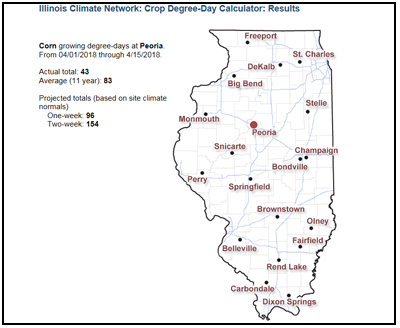
Most of us are anxiously waiting the planting season and are concerned about the delayed spring we have had this year. At the time I am writing this, there is even snow on the ground from the last weather system. This year, more than ever, I am hearing about how far behind pace we are. Is that really true?
Fortunately, the Illinois Soil Water Survey has weather data from throughout the state and has average growing degree day (GDD) accumulation records that go back several decades. If you would like to visit the webpage and do your own growing degree accumulation comparison,
click here.
As an example, I have chosen a central Illinois reporting station (Peoria), and have been tracking GDDs starting on April 1st. This April 1st date may be a possible planting date for very early corn in the region. According to the calculation (see Image 1), Peoria is only behind by 40 GDDs through the middle of April. This is based on the 11 year average, with probably a few colder years, but definitely with a few warmer years in the spring of 2012 and 2017.
So, how long does it take to get those 40 GDDs that we need to become average? Well, the average high and low temperature for Peoria this time of year is 62 and 40, respectively. To calculate growing degree days, we take the high temperature for the day plus the low temperature (50F minimum), divide by 2 and then subtract 50. For this example 62F+50F=112/2=56-50= 6 GDD average for this time of year. This ultimately means that we are less than 1 week behind the 11 year average pace. Behind pace—yes, extremely behind pace—NO!
We are still within a normal planting window with no real reason to make drastic decisions at this point in the spring. Yes, we are around 40 GDDs behind pace, but the average corn plant needs 100-120 GDDs for emergence. Putting that into perspective, our GDD shortfall is relatively small. At this time of year, patience is a virtue—plant when the environmental conditions are optimal and reap the reward of that picket fence corn stand. Have a safe spring!